Legal Landscape: Workplace Trends

Legal professionals today are challenged with navigating how their traditional practice and expertise meets the demands and opportunities of a rapidly digitizing world. Understanding the convergence of desired and evolving skills, talent preferences, and emerging technologies is critical to designing for the future of the profession as it adapts and innovates. To identify these current trends, Corgan-Hugo conducted an industry scan of key indicators— from the adoption of digital tools to the evolution of workforce expectations—to provide a snapshot of the legal landscape.
Lawyers are back in the office, but value flexibility
As many industries are transitioning back to office work, the legal industry is seeing a higher rate of employees returning to in-person work compared to others. According to the Law Firm Trends report from CRESA, at the end of January 2024, legal firms had an average of 78.1% weekly occupancy as compared to workplace occupancy pre-Covid.1 This return to office rate is about 25% higher than other industries. This is nearly the highest occupancy level since the pandemic and the number is still growing in 2024.
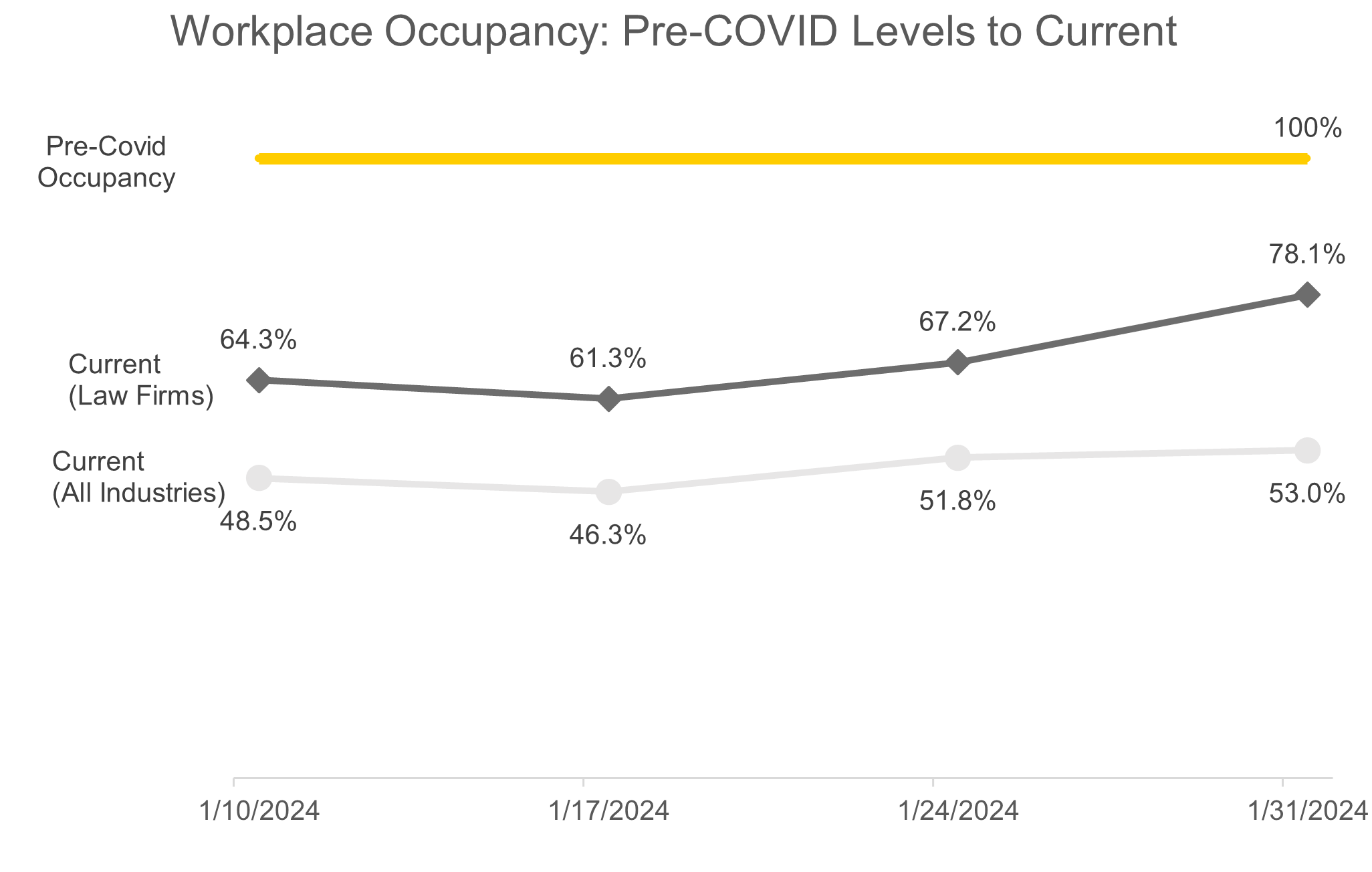
This surge in the legal industry returning to the physical office prompts a closer examination of worker preferences, especially around hybrid models. In Bloomberg Law’s survey, 92% of law firm employees shared that they desire to work remotely at least one day a week.2 This is slightly less than a typical hybrid worker: our recent study of 1,000 hybrid workers, The Hybrid Report, showed that most hybrid workers are remote one-to-two days per week.4 Law firms are on par with the rest of the industry in terms of creating hybrid policies to accommodate worker desires. In a recent CBRE survey, 83% of respondents indicated that their law firms have established hybrid work schedules and policies, which is line with the 81% of hybrid workers’ companies that have done the same.3,4
83% of law firms have established hybrid work schedules and policies while 81% of the general hybrid workforce work at companies with established flexibility policies.3, 4
Given employees’ preferences for some flexibility in a typically formal environment, the value of the workplace is increasing important to law firms. Specifically, an effective workplace helps these firms attract and retain talent. Our designs therefore can and do reflect a heightened emphasis on the physical workplace and how it can best respond to current trends in technology and employee preferences.
Technology and AI have the potential to significantly impact processes and space requirements
Cloud + Legal Technologies
The American Bar Association (ABA) 2022 Survey reports a 10% increase in the cloud usage within the legal industry over the past year, rising from 60% to 70%.5 For solo practitioners in this same study, there was an increase from 52% to 84%, while small and mid-size firms saw an increase from 65% to 75%. Law firms have adopted cloud computing for several reasons, including increased efficiency in file storage, streamlined collaboration, remote accessibility and cost efficiency. Online cloud computing offers the advantage of storing data and a lower cost compared to physical servers or file cabinets.6
The flexibility offered by cloud-based data storage becomes increasingly important with hybrid work and allowing employees to access the data anywhere and anytime, so we expect to see these percentages continue to rise in the coming years.7
The law industry's shift towards greater utilization of cloud data storage, case management software and artificial intelligence (AI) could have spatial implications for law offices based on a reduced need for onsite data storage and changing needs for in-person meeting and collaboration. Research conducted by CB Insights identified the top 10 areas of legal technology to track in coming years based on increasing relevance in the law industry.8
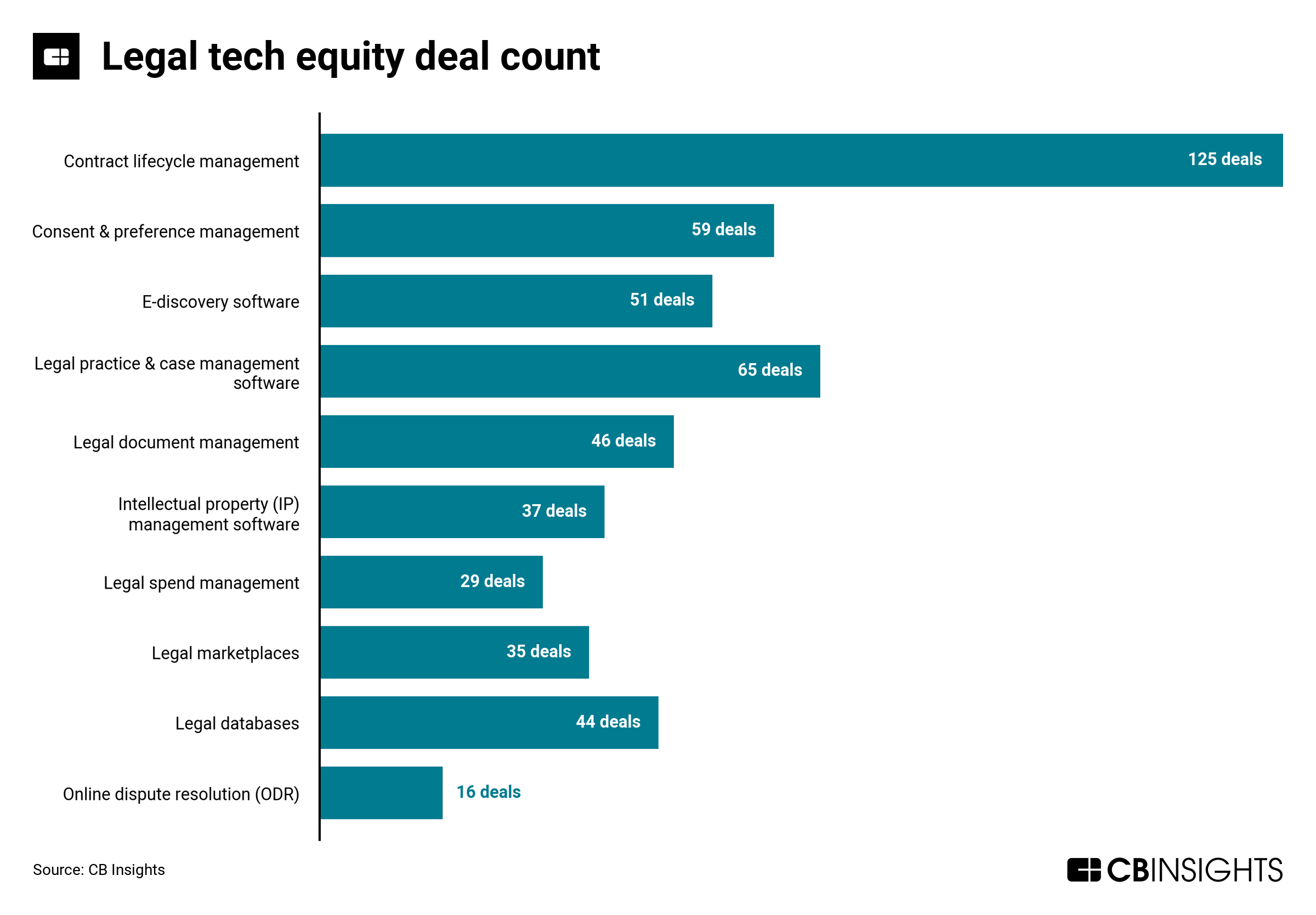
Report Name: The legal tech market map (published 10.10.2023)
Report Link: https://app.cbinsights.com/research/legal-tech-market-map/
Technologies we think may have the most potential for spatial impacts are legal document management, legal databases and online dispute resolution. The increasing use of cloud storage and management of data means law offices can reduce both onsite storage of physical documents and may reduce the need for onsite servers. Similarly, ODR offers digital solutions to resolve conflicts and disputes without the need to undergo traditional legal processes. These platforms allow parties to engage in mediation, negotiation and arbitration online rather than in-person. Thus, ODR technologies may reduce the need for in-person engagements and free up square footage for other uses. The Capgemini research highlights a shift towards more human-centric designs in workplace.9 It mentions how integrating technology and AI is transforming workplace operations, allowing attorneys to have more personalized, professional, and performance-oriented spaces equipped with high quality cameras, good lightings, and clean backgrounds.9
AI
As AI continues to grow within the legal industry, it has both provided advantages and raised concerns. According to the 2023 Profile of the Legal Profession report from ABA, 20% of lawyers believe that AI will dominate legal practice in the next three years.10 A key advantage of AI is that it can be applied in legal research to work more efficiently and with better organization.11
On the other hand, AI tools are not widely accepted in many law firms currently. According to a survey from Clio, a legal tech company, 69% of legal professionals are not using AI in their work.12 Lawyers have expressed concerns about AI, including issues with deep fakes, hallucination in text generation, and data and privacy concerns.13 However, the same percentage believe that generative AI can be used ethically in legal practice in the future.
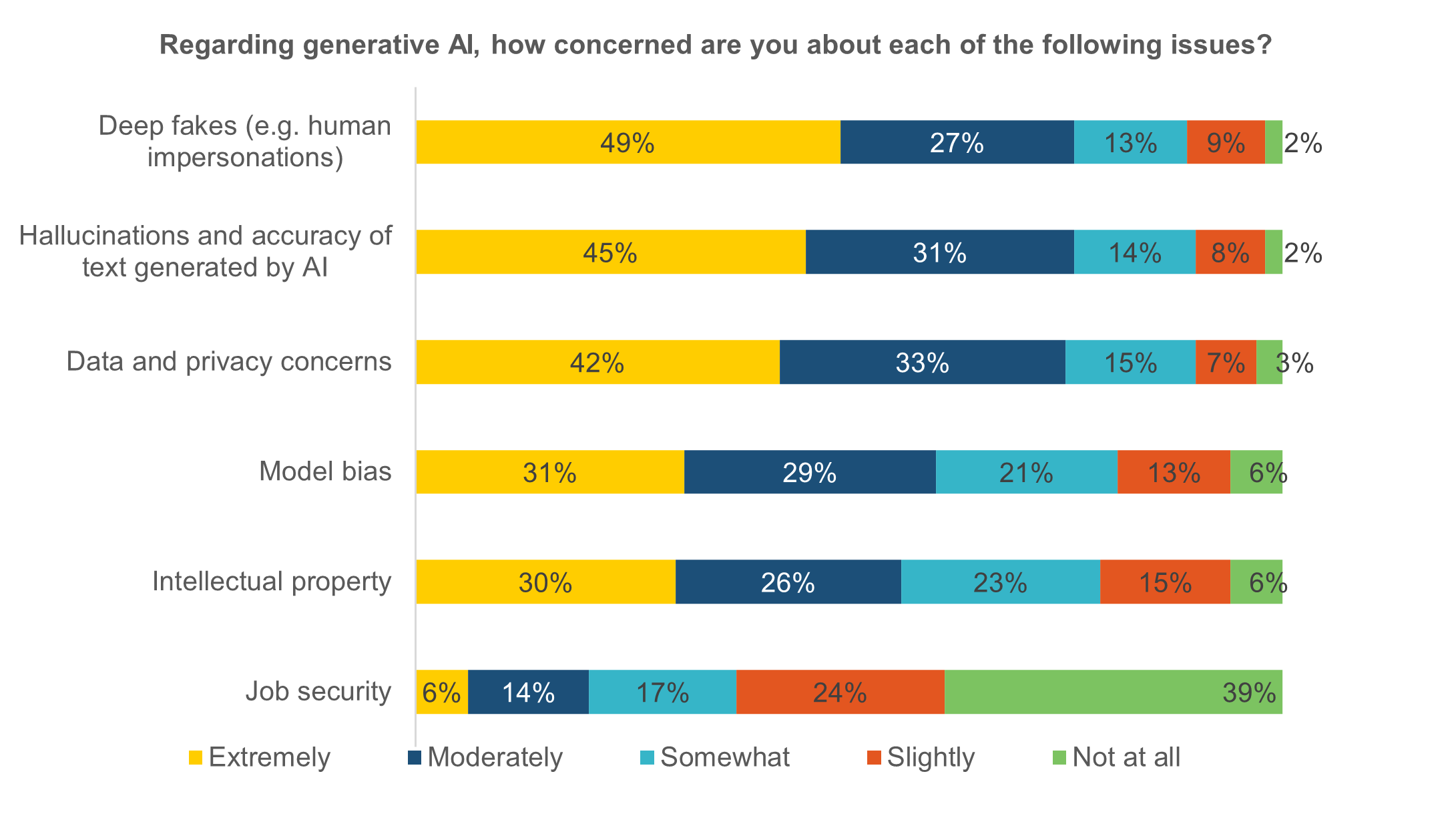
As law firms begin to cautiously adopt the use of AI, we expect to see a shift in how they interact with clients and streamline work processes. While this new technology is still evolving, it may be valuable to law firms to focus on spaces that can be flexible to future changes.
Technology is driving skill development
As legal technology and AI expand rapidly, law schools are offering legal tech programs/courses to better prepare students for their legal career. However, the Spring 2023 Law School Preparedness survey shows that only 7% and 8% of students in their second and third years, respectively, are enrolled in a legal tech course.14 This shows a significant gap in participation compared to traditional legal courses, such as legal ethics and experiential courses.
To further explore the skills being learned in law schools and those desired by hiring law firms, we collected data from the top 10 law schools ranked by U.S. News and utilized LinkedIn to analyze the skills most commonly listed by students.15 The top skills among law school students include legal research, legal writing, corporate law, and litigation. Similarly, we examined the top 10 firms listed in the AM Law 100 rankings on Law.com and analyzed the skills reported by employees.16 Comparing these findings to the skillsets of law school students in the figure below, we found that, in addition to legal research and legal writing, law firms often require proficiency in software tools such as Microsoft Office and Microsoft Excel.
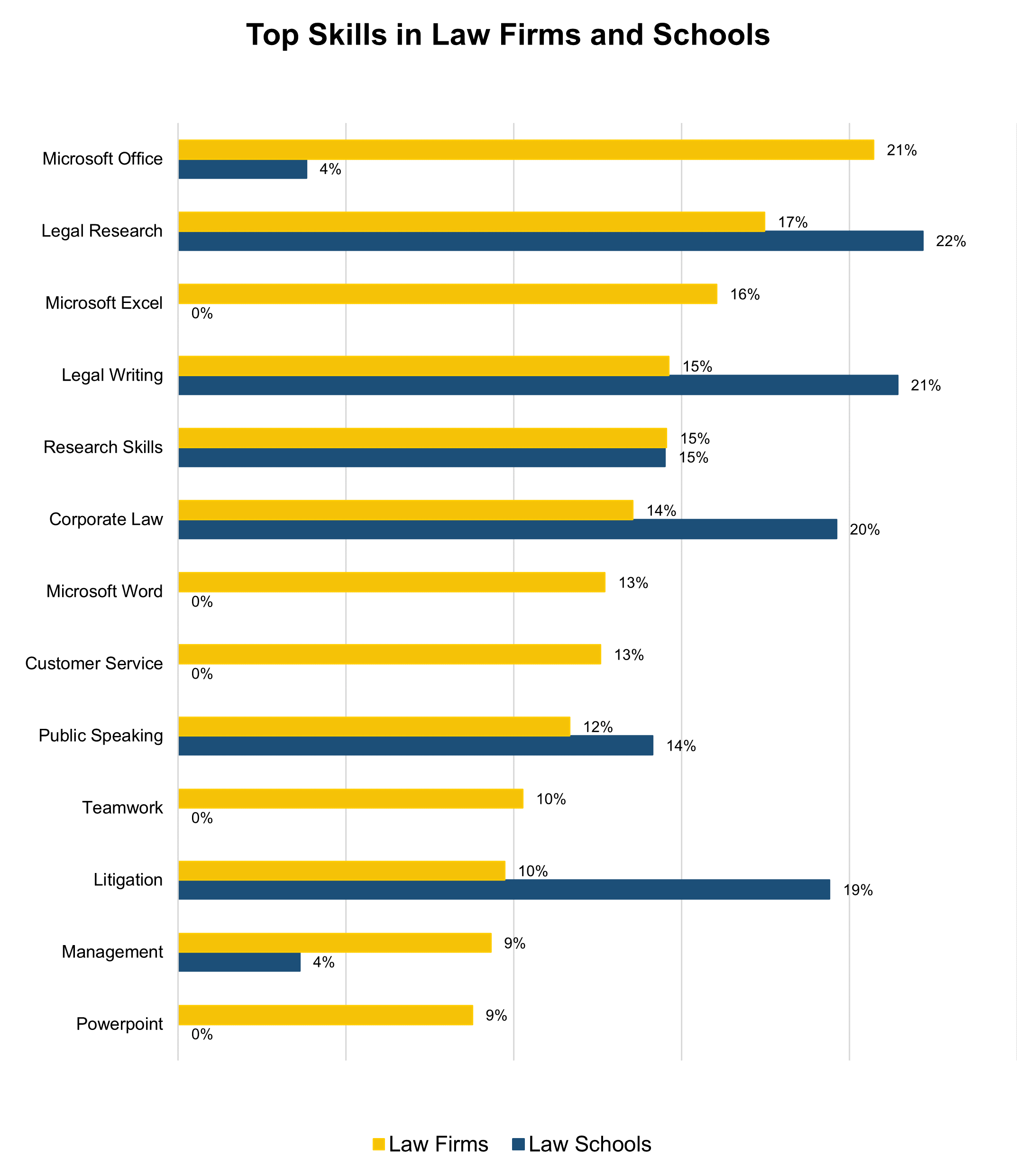
From this research, it is clear there is gap between the legal tech skills for students and those required of incoming practitioners. According to Bloomberg Law, there will be a big shift towards legal technology use in the future, and schools need to teach students both practical skills and technological skills.14 Law firms themselves may need to supplement this education on the job with additional training and mentorship.
Law career opportunities are growing in the Southeast
Another change in the law industry is increasing career opportunities in the southeastern United States. According to ABA data, New York, Massachusetts, Connecticut, Illinois, and Minnesota have the most lawyers per capita of any state.10
In 2023, there were over 1.3 million lawyers in the United States, representing a 5% growth over the past 10 years.10 Florida had the most significant increase in the number of lawyers, with a 23.6% rise since 2013, adding over 16,000 lawyers.
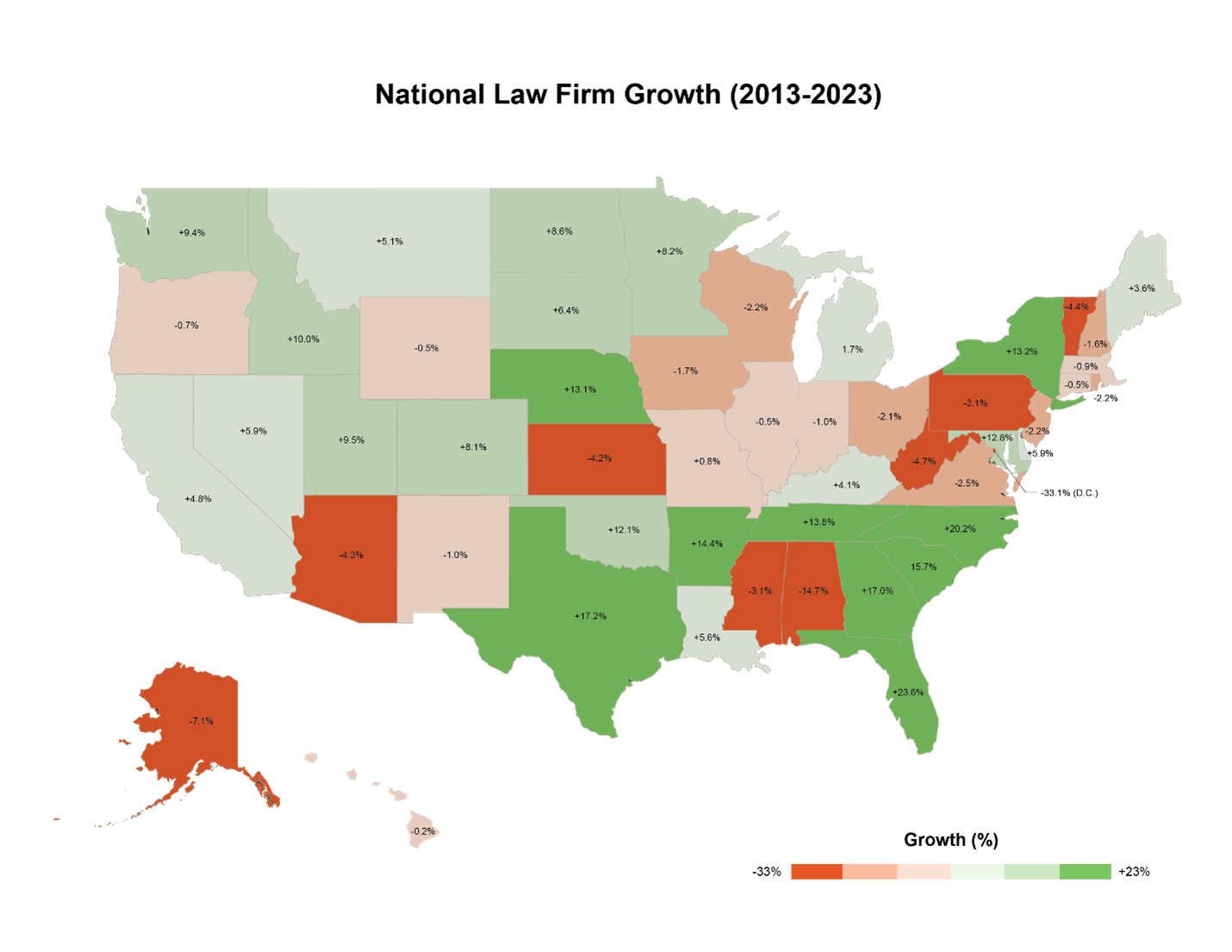
The map shows a significant increase in southeastern area, especially in Florida, North Carolina, South Carolina, and Georgia. In the northeastern region, New York is a notable exception with a 13.2% rise.10 Moreover, New York also has the highest number of lawyers per capita, with 9.6 lawyers for every 1,000 residents in 2023. In the midwestern area, Kansas and Wisconsin have experienced a notable reduction in lawyers. In western regions, Idaho and Washington have higher growth rates, while Alaska and Nevada have a decline over the past decay.
Metro areas with the highest demand for law services are Washington, D.C., New York City, Tallahassee, Miami, and Santa Fe.29
As career opportunities for talent grows in areas outside of large, coastal cities, there will also be a demand for more offices or revitalized offices to help attract top talent.
Lawyers are interested in opportunities for enhance wellness, socialization and mentorship
When it comes to what is offered on the job and in the office, it is important to understand what lawyers value most personally and to support their progressing careers.
Due to the unpredictable nature of their jobs, many lawyers have variable work schedules that require them to work outside of traditional office hours. According to Clio’s 2022 Legal Trends Report, 86% of respondents indicated that they don’t work regular hours, and 73% of respondents don’t work a regular work week.12 Thus, lawyers often have a blurred boundary between work and life. This variability can impact overall health and wellbeing: 68% of respondents in Bloomberg’s Law Attorney Workload and Hours Survey reported work-related issues affecting their sleep, while 65% reported having anxiety.37 However, 72% of respondents in the survey continue to engage in exercise as part of their weekly self-care routine.
Our research also explored what on-site amenities law firms are offering as a benefit to their employees. Latham & Watkins, with 2,280 employees in 13 offices across the U.S., offers on-site health centers staffed with nurse practitioners, physical therapists, and mental health counselors in its Los Angeles and New York offices.38 Baker McKenzie provides sports and fitness areas, as well as yoga and meditation sessions, for employees to exercise and relax.39 Akin Gump, a large U.S. law firm with 723 employees, offers child-care services and provides a supportive work environment to parents.40 Patterson Belknap Webb & Tyler, a mid-sized firm with 187 U.S. employees, provides an on-site cafeteria and hosts office socials.41, 42 Zuckerman Spaeder, a small firm with 66 U.S. employees in three offices, provides an on-site fitness center, roof terrace, and food and drinks.43, 44 Additionally, it provides flexible work schedules and opportunities for professional development.44
From our overall analysis of 20 firms of various sizes, small to mid-size firms typically prioritize offerings such as supportive working environments and professional development opportunities, while large to extra-large firms often have invested in space-based amenities like gyms, health centers, and cafeterias.
Opportunities for Mentorship
Mentorship and culture also play pivotal roles in shaping employee experience and success in the workplace. In the Bloomberg Law Survey, nearly half of respondents indicated that they have people they consider mentors at work.45 CBRE’s 2024 Law Firm Benchmarking Survey reported that while home offices may provide a better environment for attorneys to focus and provide additional comfort, some intangible office benefits (such as mentoring and relationship building) are more likely to take place in the office.3

To facilitate this benefit, law offices should have designated space for collaboration and mentoring. Improving the functionality and comfort of individual offices can encourage lawyers and staff to return to the office for in-person collaboration. Implementing effective design strategies in private offices, such as creating a flexible workplace and integrating technology upgrades, support collaboration among team memebers46. Moreover, individual offices can foster collaboration in training and mentoring associate lawyers. Having separate offices allows senior attorneys to more easily engage in one-on-one meetings. Leaders in law firms are prioritizing the redesign of office spaces to promote collaboration, despite the shift towards remote work, because “law is a collaborative profession”.47 Rick Ginsberg from Cooley highlighted in a recent interview that a combination of private offices, open spaces, and collaborative meeting rooms would create a better environment for teamwork.47 However, law firms are shifting to create spaces for people to talk and collaborate in a less formal way
Designing for new demands
As the law industry adapts to the new demands of hybrid work, technology adoption, and talent, it becomes increasingly important to treat the workplace as a tool. By having a workplace that supports the people in it, and is responsive to shifts in preferences and technology, it can enhance a firm’s effectiveness.
References
- CRESA. (2024). 2024 Law Firm Tends from CRESA. https://www.cresa.com/Market-Research/2024-Law-Firm-Trends
- Blaemire, J. R. (2023, November 5). Analysis: Female, minority attorneys will pursue job flexibility. Bloomberg Law. https://news.bloomberglaw.com/bloomberg-law-analysis/analysis-female-minority-attorneys-will-pursue-job-flexibility
- CBRE. (2024, March 5). Law Firm Benchmarking Survey Results 2024 from CBRE. https://www.cbre.com/insights/reports/law-firm-benchmarking-survey-results-2024
- Hoelting, M., Afkhami, M., Flores, S., & Desooky, A. (2023, August 17). The hybrid report from Corgan. https://www.corgan.com/sites/default/files/inline-files/TheHybridReport_2023_Corgan.pdf
- Kennedy, D. M. (2022, November 17). 2022 cloud computing TechReport from American Bar Association. https://www.americanbar.org/groups/law_practice/resources/tech-report/2022/cloud-computing
- Brock, C. (2023, June 8). Why and how are law firms moving to the cloud? From LawPay. https://www.lawpay.com/about/blog/cloud-computing-for-law-firms/
- ACTIONSTEP. (2020, April 14). Free cloud software for law firms during COVID-19 from ABA Law Practice Today. https://www.lawpracticetoday.org/article/free-cloud-software-for-law-firms-during-covid-19/
- CB Insights. (2023, October 10). The legal tech market map. CB Insights. https://app.cbinsights.com/research/legal-tech-market-map/
- Connolly, A., McMahon, J., & Ulaniuk, L. (2024, January 22). Five transformative trends in the digital workplace for 2024 from Capgemini. https://www.capgemini.com/insights/expert-perspectives/five-transformat…;
- American Bar Association. (2023). Profile of the legal profession from American Bar Association. https://www.americanbar.org/content/dam/aba/administrative/news/2023/potlp-2023.pdf
- Bloomberg Law. (2023). Artificial Intelligence for Lawyers Explained from Bloomberg Law. https://pro.bloomberglaw.com/insights/technology/ai-in-legal-practice-explained/
- Clio. (2022). 2022 Legal Trends Report from Clio. https://www.clio.com/resources/legal-trends/
- Bloomberg Law. (2023). Tech & Compensation from Bloomberg Law. https://aboutblaw.com/bawK
- Bloomberg Law. (2023). Law School Preparedness from Bloomberg Law. https://aboutblaw.com/9Qq
- U.S. News. (2024). 2024 Best Law Schools from U.S. News. https://www.usnews.com/best-graduate-schools/top-law-schools/law-rankings
- Law.com. (2024). Law Firms from Law.com. https://www.law.com/law-firms/
- LinkedIn. (2024). Sidley Austin LLP from LinkedIn. https://www.linkedin.com/company/sidley-austin/insights/
- LinkedIn. (2024). Ropes & Gray LLP from LinkedIn. https://www.linkedin.com/company/ropes-&-gray-llp/people/
- LinkedIn. (2024). Gibson Dunn from LinkedIn. https://www.linkedin.com/company/gibson-dunn/people/
- LinkedIn. (2024). Morgan, Lewis & Bockius LLP from LinkedIn. https://www.linkedin.com/company/morgan-lewis-&-bockius-llp/
- LinkedIn. (2024). White & Case LLP from LinkedIn. https://www.linkedin.com/company/white-&-case/
- LinkedIn. (2024). Skadden, Arps, Slate, Meagher & Flom LLP and Affiliates from LinkedIn. https://www.linkedin.com/company/skadden-arps-slate-meagher-flom-llp-affiliates/
- LinkedIn. (2024). DLA Piper from LinkedIn. https://www.linkedin.com/company/dla-piper/
- LinkedIn. (2024). Latham & Watkins from LinkedIn. https://www.linkedin.com/company/latham-&-watkins/
- LinkedIn. (2024). Kirkland & Ellis from LinkedIn. https://www.linkedin.com/company/kirkland-&-ellis-llp/
- LinkedIn. (2024). Stanford Law School from LinkedIn. https://www.linkedin.com/school/stanford-law-school/
- LinkedIn. (2024). Yale Law School from LinkedIn. https://www.linkedin.com/school/yale-law-school/
- LinkedIn. (2024). University of Chicago Law School. https://www.linkedin.com/school/university-of-chicago-law-school/
- LinkedIn. (2024). University of Pennsylvania Carey Law School from LinkedIn. https://www.linkedin.com/school/university-of-pennsylvania-carey-law-school/
- LinkedIn. (2024). Duke University School of Law from LinkedIn. https://www.linkedin.com/school/dukelaw/
- LinkedIn. (2024). Harvard Law School from LinkedIn. https://www.linkedin.com/school/harvard-law-school/
- LinkedIn. (2024). New York University School of Law from LinkedIn. https://www.linkedin.com/school/new-york-university-school-of-law/
- LinkedIn. (2024). Columbia Law School from LinkedIn. https://www.linkedin.com/school/columbia-law-school/
- LinkedIn. (2024). University of Virginia School of Law from LinkedIn. https://www.linkedin.com/school/uvalaw/
- LinkedIn. (2024). Northwestern University from LinkedIn. https://www.linkedin.com/school/northwestern-university-school-of-law/
- LinkedIn. (2024). Baker McKenzie from LinkedIn. https://www.linkedin.com/company/baker-&-mckenzie/people/
- Bloomberg Law. (2024). Attorney Workload and Hours (2023 Q1 &Q2) from Bloomberg Law. https://aboutblaw.com/baNK
- Latham & Watkins. (2024). Compensation & Benefits from Latham & Watkins. https://www.lwcareers.com/en/beginning-your-legal-career/united-states/compensation-benefits
- Baker McKenzie. (2024). Benefits from Baker McKenzie. https://hkg-graduates.bakermckenzie.com/about/benefits/
- Akin Gump Strauss Hauer & Feld LLP. (2024, May 20). Akin Gump Named a Top Firm for Working Mothers by Yale Law Women from Akin Gump Strauss Hauer & Feld LLP. https://www.akingump.com/en/insights/press-releases/akin-gump-named-a-top-firm-for-working-mothers-by-yale-law-women
- U.S. News. (2024). Patterson, Belknap, Webb & Tyler LLP from U.S. News. https://law.usnews.com/law-firms/patterson-belknap-webb-&-tyler-llp-865
- Patterson Belknap. (2024). Benefits from Patterson Belknap. https://www.pbwt.com/careers/benefits
- U.S. News. (2024). Zuckerman, Spaeder LLP from U.S. News. https://law.usnews.com/law-firms/zuckerman-spaeder-llp-997#OfficeLocations
- Zuckerman Spader. (2024). Employee Benefits from Zuckerman Spader. https://www.zuckerman.com/employee-benefits
- Huie, M. (2023, November 5). Analysis: Mentorship is a must to keep dei afloat in 2024 from Bloomberg Law. https://news.bloomberglaw.com/bloomberg-law-analysis/analysis-mentorship-is-a-must-to-keep-dei-afloat-in-2024
- Wu, F. (2022, August 23). To Get Workers to Return to the Office, Redesign Spaces for Collaboration from Build In. https://builtin.com/company-culture/redesign-office-for-collaboration
- Maloney, A. (2021, October 18). Law firm leaders idealize “collaboration” in the Office Space Race, despite so much change from The American Lawyer. https://www.law.com/americanlawyer/2021/10/18/law-firm-leaders-idealize-collaboration-in-the-office-space-race-despite-so-much-change/







